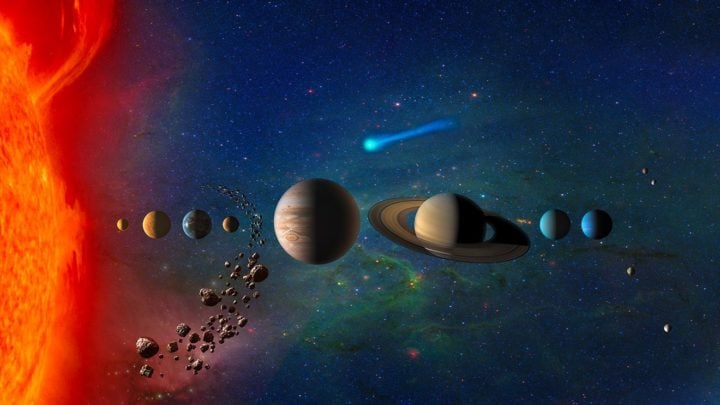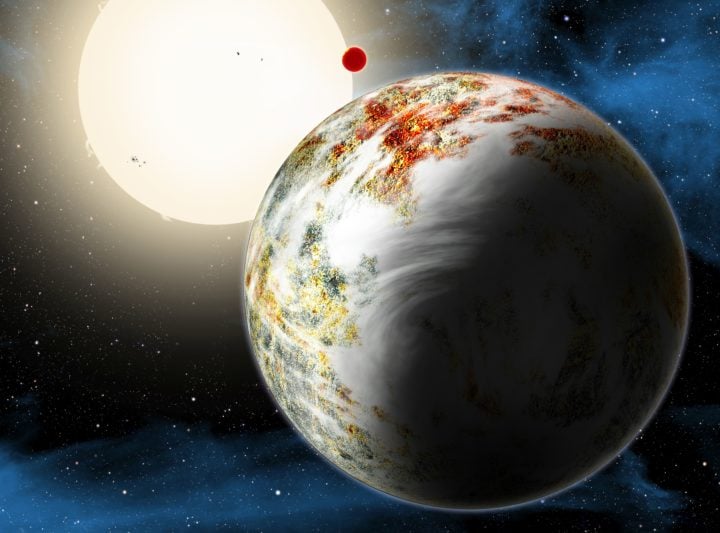Assistant Professor Marta Bryan is studying the properties of exoplanets to better understand how our planet and species fit into the larger universe.
It wasn’t that long ago that astronomers only knew of eight planets (nine before Pluto’s demotion back in 2006) – those here in our own solar system. Now we know of nearly 10,000 planets orbiting stars beyond our sun – known as exoplanets – and that flood of new worlds has ushered in something of a golden age for planetary scientists.

An illustration shows our solar system (not to scale). Image credit: NASA/JPL-Caltech
For astronomers like Marta Bryan, an assistant professor at the University of Toronto Mississauga and in the David A. Dunlap department of astronomy and astrophysics in the Faculty of Arts & Science, it means there’s no better time to be studying these distant worlds.
“This is such a dynamic field,” says Bryan, who joined U of T in January after four years as a postdoctoral researcher at the University of California, Berkeley.
Studying the properties of exoplanets provides “a unique opportunity to put ourselves and our world in the broadest of contexts – how does our solar system, our planet and our species fit into our universe?”
Bryan, who specializes in the study of planetary formation and evolution, was recently awarded the Annie Jump Cannon Award from the American Astronomical Society for her work on exoplanets.

Marta Bryan uses a range of observational techniques to detect and characterize gas giant planets outside our solar system to explore how planetary systems form and evolve. Image credit: Nick Iwanyshyn, University of Toronto
As the tally of exoplanets began to grow, astronomers noticed how diverse planetary systems appear to be, with planets varying widely in size, composition and surface temperature. Some orbit very close to their host stars, while others follow orbits comparable to the Earth’s, or to the giant outer planets in our solar system.
“We’ve found thousands of exoplanets, with a huge diversity of properties,” Bryan says. “For me, one of the driving goals in the field is to understand where that diversity comes from. What does the process of planet formation and evolution look like?”
While much research on exoplanets has focused on the search for Earth-like worlds, Bryan is interested in gas giant planets, analogous to Jupiter and Saturn in our own solar system. That’s because their sheer heft means they play an important role in determining how smaller planets in the same system evolve.

Exoplanet Kepler-10c – artistic concept. Image credits: Harvard-Smithsonian Center for Astrophysics/David Aguilar
As Bryan puts it, gas giant planets “dominate the dynamics” of whatever system they’re in. Which means that learning about gas giants can, in fact, help us understand something about Earth-like planets – worlds whose evolution may have been affected by the presence of these much more massive bodies.
As a result, Bryan says, “gas giant planets are an obvious place to start if we want to understand the physics of planet formation.”
The gas giant planets in our own solar system are thought to have played a crucial role over the past five billion years. Jupiter, for example, is believed to have migrated inward before reversing direction and ending up in its current position.
Jupiter’s foray into the inner part of the solar system is thought to have stunted the growth of the inner planets, particularly Mars, by scattering some of the gas and dust that might otherwise have been gravitationally pulled toward the red planet.
“We think that Jupiter and Saturn played a dominant role in the early history of our solar system, helping to shape the formation and evolution of our terrestrial planets,” Bryan says.
“As a result, we want to understand in the broader extrasolar context what role gas-giant analogs to Jupiter and Saturn have played in shaping the lives of terrestrial worlds.”
The future looks bright – data from the James Webb Space Telescope is already pouring in. Bryan is especially excited about large, ground-based telescopes with mirrors up to 30 metres across, which are currently being planned.
These next-generation telescopes may even reveal “biosignatures” on other worlds – signs of life that can be inferred from the composition of a planet’s atmosphere.
And if astronomers do end up finding conclusive evidence of life beyond our own planet, such a discovery “would definitely be transformational,” Bryan says.
Source: University of Toronto

